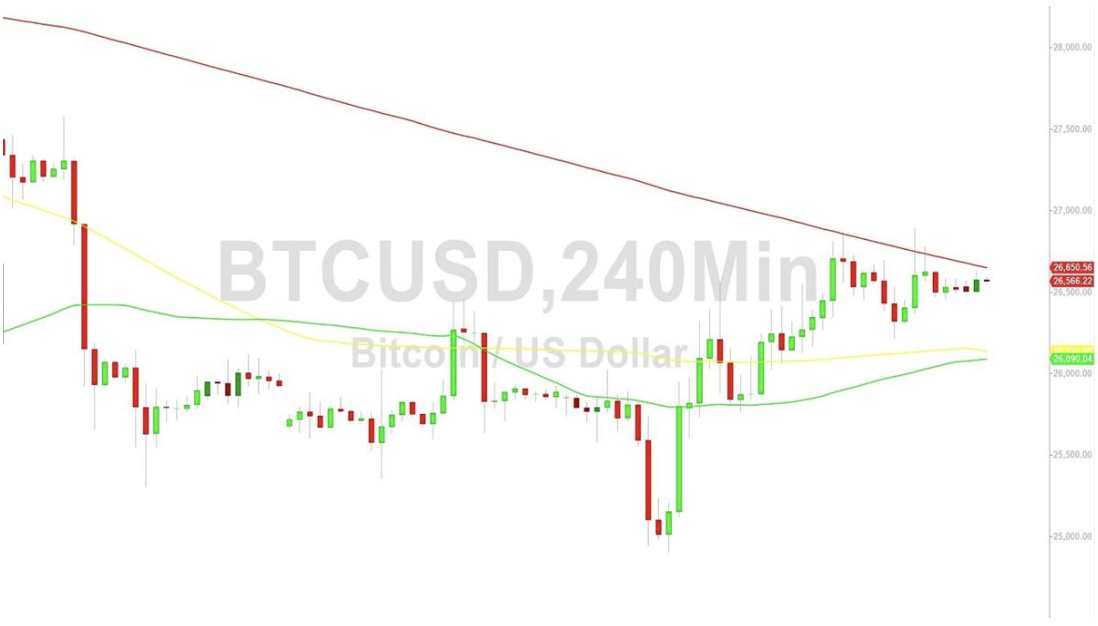Buy Bitcoin (BTC)
Bitcoin Price
Bitcoin, which has been in existence since 2009, is the world's first digital currency. It was created by an individual or group using the name Satoshi Nakamoto and currently has a market capitalization of $503.72B. The details of this groundbreaking invention can be found in Nakamoto's whitepaper "Bitcoin: A Peer-to-Peer Electronic Cash System".
Bitcoin Price Live
The price of Bitcoin is highly variable and influenced by numerous factors, including supply, demand, and external forces. Over the years, its value has experienced significant fluctuations, marked by sharp increases and declines. You can find real-time updates on Bitcoin prices in the chart displayed at the top of this page. As of September 15th, 2023, the current live Bitcoin price stands at $26,553.39 USD with a 24-hour trading volume of $12.73B USD. In the past day, it increased by 0.84%.
Bitcoin has numerous advantages over traditional money. It allows for international money transfers, without the need for involvement from a central authority. Additionally, Bitcoin transactions incur low fees and offer resistance to inflation. Another key benefit is that transactions cannot be restricted, controlled, or censored by any third parties due to its decentralized nature.For people in countries with unstable currencies or inflation issues, BTC can serve as a secure store of value.
Bitcoin Chart
On this page, you can find a chart that displays the live price of Bitcoin in USD. The x-axis represents time and the y-axis represents the price. Green candles indicate periods when the price increased, while red candles show periods when the price decreased. The length of each candle represents the difference between the opening and closing prices during that period. The upper and lower wicks indicate the highest and lowest prices reached throughout that period. You have options to zoom in or out, change the time frame, and utilize different indicators and tools for analyzing price trends. This Bitcoin graph is a valuable resource for tracking its price changes over time.

The chart also shows some important information about Bitcoin, such as its current price, market capitalization, trading volume, 24-hour change, and 52-week range. You can also see the current fear and greed index of Bitcoin, which measures the sentiment of investors based on various factors such as volatility, social media activity, market dominance, and more. The index ranges from 0 to 100, where 0 means extreme fear and 100 means extreme greed.
You can use a Bitcoin calculator to convert the price of Bitcoin to other currencies or assets, such as gold, silver, or stocks. You can also use the calculator to estimate how much Bitcoin you can buy or sell with a certain amount of money.
Bitcoins can be obtained in a few different ways. Some common options include buying BTC on a cryptocurrency exchange accepting bitcoin payments as a merchant, mining bitcoin using your computer's processing power, receiving bitcoin from someone you know, or earning bitcoin through specialized work like microtasks. Bitcoin ATMs and peer-to-peer exchanges are also available in some locations.
Depending on your preferences and goals, there are different ways to buy Bitcoin. Some of these ways include;
- Spot buying: This is the most basic form of buying Bitcoin, where you purchase the cryptocurrency at its current market price. This is the most straightforward way to invest in Bitcoin, but it also carries the most risk, as the price of Bitcoin can be highly volatile.
- Leverage buying: Leverage buying involves borrowing money to invest in Bitcoin, with the hope of earning a higher return. This can be a risky strategy, as it can amplify both gains and losses.
- Dollar-cost averaging: This is a strategy where you invest a fixed amount of money in Bitcoin at regular intervals, regardless of its current price. This can help to reduce the impact of short-term price fluctuations on your investment.
If you're interested in buying Bitcoin, you can use the following link to purchase it: Buy it on ByBit and get deposits bonuses worth $30k. However, it's important to note that this is not specific advice and you should do your own research before making any investment decisions.
Bitcoin Halving
One major fundamental factor that can affect Bitcoin's price is the Bitcoin halving. The Bitcoin halving is a scheduled reduction in the mining reward that occurs once every 210,000 blocks mined or approximately every four years. Bitcoin mining is the process by which new bitcoins are entered into circulation, as well as the process that verifies and secures bitcoin transactions.\

The first halving occurred in November 2012, when the block reward was reduced from 50 BTC to 25 BTC. The second halving occurred in July 2016, when the block reward was reduced from 25 BTC to 12.5 BTC. The third halving occurred in May 2020, when the block reward was reduced from 12.5 BTC to 6.25 BTC. The next halving is expected to occur in April or May 2024, when the block reward will be reduced from 6.25 BTC to 3.125 BTC.
Past Bitcoin halvings have preceded some of Bitcoin's largest bull runs. With the supply rate cut in half, many investors expect increased scarcity will lead to appreciation in Bitcoin's value. However, the impact of the halving on Bitcoin's price is debated, as demand also plays a key role. If the halving coincides with increased institutional and retail interest in Bitcoin, major price rises may ensue. But if demand falters, the impact could be more muted. The 2024 halving could potentially push Bitcoin's price to new highs, but the community will have to wait to see how the complex market dynamics play out.
Bitcoin Price History
Bitcoin's price history has been volatile, with significant spikes and crashes. Its price fluctuations primarily stem from investors and traders betting on an ever-increasing price in anticipation of riches. Bitcoin had a price of zero when it was introduced in 2009. On July 17, 2010, its price jumped to $0.09. Bitcoin's price rose again on April 13, 2011, from $1 to a peak of $29.60 by June 7, 2011, a gain of 2,960% within three months. A sharp recession in cryptocurrency markets followed, and Bitcoin's price bottomed out at $2.05 by mid-November.
The following year, its price rose from $4.85 on May 9 to $13.50 by Aug. 15. The year 2012 proved to be a generally uneventful year for Bitcoin, but 2013 witnessed strong gains in price. Bitcoin began the year trading at $13.28 and reached $230 on April 8. An equally rapid deceleration in its price followed, bringing it down to $68.50 a few weeks later on. As of February 27, 2023, Bitcoin seems to be regaining some of the luster it lost during the crippling crypto winter of 2022, holding fairly steady above the $20,000 mark (but far off its November 2021 all-time high of $68,789.63).
Bitcoin Price Prediction
Given Bitcoin's highly volatile past, making accurate long-term Bitcoin price predictions is challenging, as its price is influenced by many factors that are often beyond anyone's control or expectation. Many professional cryptocurrency analysts believe Bitcoin has strong potential for significant price growth both in the short and long term. On the more conservative end, some predict BTC reaching $30,000 by the end of 2023. More bullish forecasts have a $50,000-$100,000 target within the next 1-3 years.
The price of Bitcoin is influenced by a variety of factors, including market demand and supply, regulatory changes, and technological advancements. It is important to conduct thorough research and analysis before making any investment decisions.
In conclusion, No one can say for sure where Bitcoin's price will head, but its fixed supply, widespread utility, and monetary properties suggest the original cryptocurrency's future remains bright. We encourage staying up-to-date on expert analysis as well as monitoring our Bitcoin price chart to make informed decisions regarding this innovative asset's outlook.
What is Bitcoin?

How does Bitcoin work?

What is the current price of Bitcoin?

How can I buy Bitcoin?










